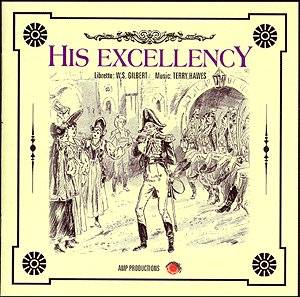When reviewing a pastiche of Sullivan’s music it is
always difficult to know whether to judge the work on its own merits
or from a likeness to the original it is trying to represent. When Gilbert
wrote His Excellency it was set to music, not by Sullivan, but
by Osmond Carr. Carr’s music was uninspired and the work went down as
a failure. However, the libretto (long ago published in the Chatto &
Windus collection of Gilbert’s plays) concerning a practical joke-playing
governor of a Danish town reads well, and in my opinion is far superior
to Gilbert’s last Savoy opera with Sullivan, The Grand Duke (1896).
The earlier His Excellency shares some similarities. Staged at
George Edwards’ Lyric Theatre in October 1894 the initial run was disappointing:
Carr took only a modest portion of the receipts realising that much
of the failure was due to the music. The work was never revived, that
is until now. Had Hawes been given the opportunity to substitute his
music in 1894 I have no doubt the opening run might have been a roaring
success.
This production follows the style of Thespis
where composers/arrangers set out to fit existing Sullivan music from
other sources or recompose afresh in the vein of Sullivan. Terry
Hawes does the latter and achieves more competency than others who
attempted productions of Thespis between the ’Sixties and ’Eighties.
Hawes’ music is very fitting, perhaps more Edwardian than Victorian
in flavour (tk7 Here are the warriors) yet his compositions carry
a good likeness to Sullivan. A hint of Offenbach, Auber (Manon Lescaut)
tk24, Lecocq (Fille de Mme Angot) tk17 and, dare I say it, Anna
Russell, drift in from time to time, but since Sullivan himself was
influenced by Auber and Offenbach, this is justified. The music is fresh
and engaging and fit the lyrics and recitatives most appropriately.
On the other hand, similarities to actual numbers is found: tk8 contains
vocal lines whose inspiration has clearly come from the Lord Chancellor’s
song (Iolanthe) while elsewhere I recognise composition models
taken from Haddon Hall and The Grand Duke (both written
within a few years of the original Excellency production). I
hasten to add that these likenesses are subtle and not in the vein of
Bruce Montgomery perhaps, where opening bars of familiar Sullivan numbers
are used before running into new Thespis compositions. It is
clear that Hawes has studied Sullivan carefully and knows the Savoy
Operas inside out to enable him to produce the delightfully bright Sullivanesque
numbers found on this disc. His orchestration seems somewhat heavier
than Sullivan would score and are more like Offenbach. (When Michael
Harris carried out his brilliant scoring from the piano version
of the Sapphire Necklace song Over the Roof [see
review] he was aware that Sullivan’s orchestration was characteristically
light with effectively simple decoration and a vocal line often accompanied
by one wind instrument for a few lines of a verse and then passing on
to another whilst thickening with horns, etc. to give bloom with tied
notes.) These characteristics of Sullivan are not very evident to my
ears, but the forward orchestra could be affecting my judgement. But
this is a minor point, however. One needs to look at the broad canvas
instead, and for me the quality of John Dervish’s production makes very
enjoyable listening. Should Terry Hawes attempt to compose a new version
of Thespis then I am sure the result would be very good.
The production here is very professionally executed:
the singers are more than proficient and the orchestra is made up of
flawless musicians. Musical direction by Terry Hawes commands a brisk
pace and the singers and orchestra responds admirably. Of the singers
themselves, certain Hawes’ numbers demand a wide compass with unusually
high notes yet all cope without an indication of strain. Perhaps Griffenfeld
in (tk17) is a little insecure on long held notes. Diction is excellent
in this warm recording. The singers’ miking is close and a short delay
reverb. is used to usefully thicken the orchestra rather than provide
an artificially-spacious echo. If anything, the orchestra is a little
too forwardly placed to be ideal.
An extremely attractive CD presentation case accompanies the disc (not
a jewel case, more like those of certain French labels) with good notes,
synopsis and libretto in English. Noticing Michael Walters’ involvement
I might have hoped for more comment about the history associated with
this work, but realise that copy space was probably at a premium. This
recording will not disappoint those keen on exploring this genre. I
had seen an advertisement in the G&S News some months ago, but at
the time Hawes was unknown to me and I imagined, wrongly, that this
might have been one of those mediocre amateur productions whose recordings
are variable. Not a bit of it! No information apart from web address—
www.hisexcellency.co.uk
is given on the CD and orders are taken on that site. An outer London
telephone number contact is also available on +44 (0)20 8341 6767
Raymond Walker


